Neem oil’s azadirachtin compound infiltrates thrips’ hormonal systems, disrupting their ability to molt and reproduce while acting as a powerful feeding deterrent. When you apply neem oil solution, it targets these tiny 1-2mm pests at multiple life cycle stages, preventing their development and causing them to stop eating your plants. The oil can reduce thrip populations by up to 90% when applied consistently every 7-14 days. Understanding the proper application techniques will maximize your success against these destructive garden invaders.
Understanding Thrips: The Hidden Garden Destroyer
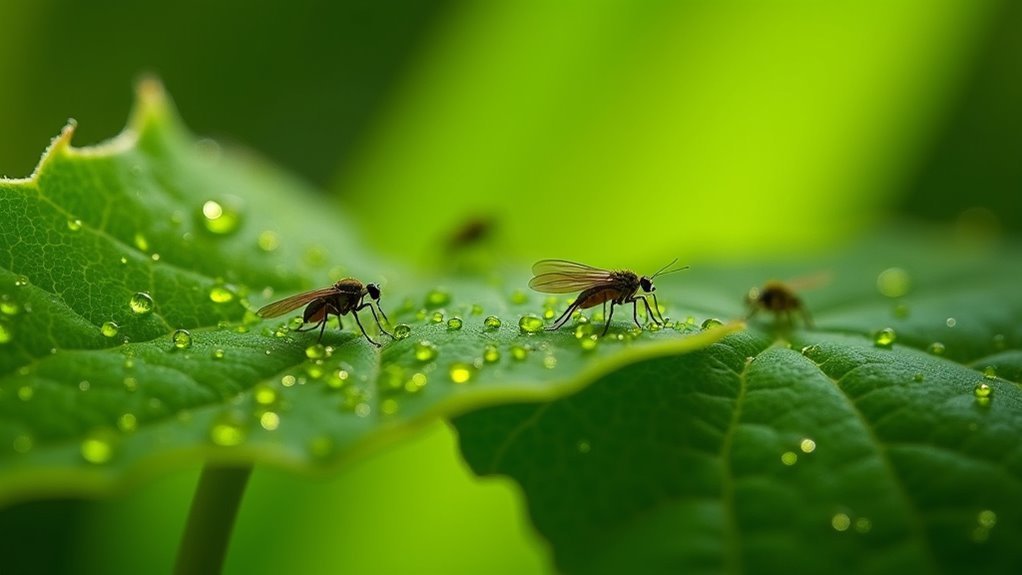
Imagine discovering your prized garden plants mysteriously developing silvery streaks and distorted leaves—you’re likely dealing with thrips, one of gardening’s most elusive pests.
These tiny insects, measuring just 1-2 mm long, wreak havoc by feeding on leaves and flowers while hiding in crevices where they’re nearly impossible to spot.
These microscopic garden invaders measure barely 1-2 mm yet cause devastating damage while remaining virtually invisible to gardeners.
What makes thrips particularly destructive is their rapid reproduction rate—females can lay up to 200 eggs, causing infestations to explode quickly.
They don’t just damage plants through feeding; they also transmit harmful viruses that compound the destruction.
You’ll need monitoring techniques strong enough to catch early signs like silvering leaves and black fecal spots.
Fortunately, neem oil offers an effective solution against these hidden garden destroyers.
How Neem Oil Disrupts Thrips Life Cycles
While thrips may seem nearly unstoppable with their rapid reproduction cycles, neem oil targets their most vulnerable point—their hormonal development system. The active compound azadirachtin disrupts significant hormonal processes, preventing thrips from maturing and reproducing effectively. This interference creates a domino effect throughout their population.
When you apply neem oil regularly, it affects thrips at multiple life stages. Larvae can’t develop properly into adults, while existing adults struggle with feeding and egg-laying.
The oil creates a protective barrier on your plant surfaces, making leaves less attractive for feeding and reproduction. You’ll notice thrips begin starving as their feeding behavior becomes disrupted.
This combination of developmental interference and feeding disruption breaks their life cycle, gradually reducing populations and protecting your plants from further damage.
Active Compounds in Neem Oil That Target Thrips
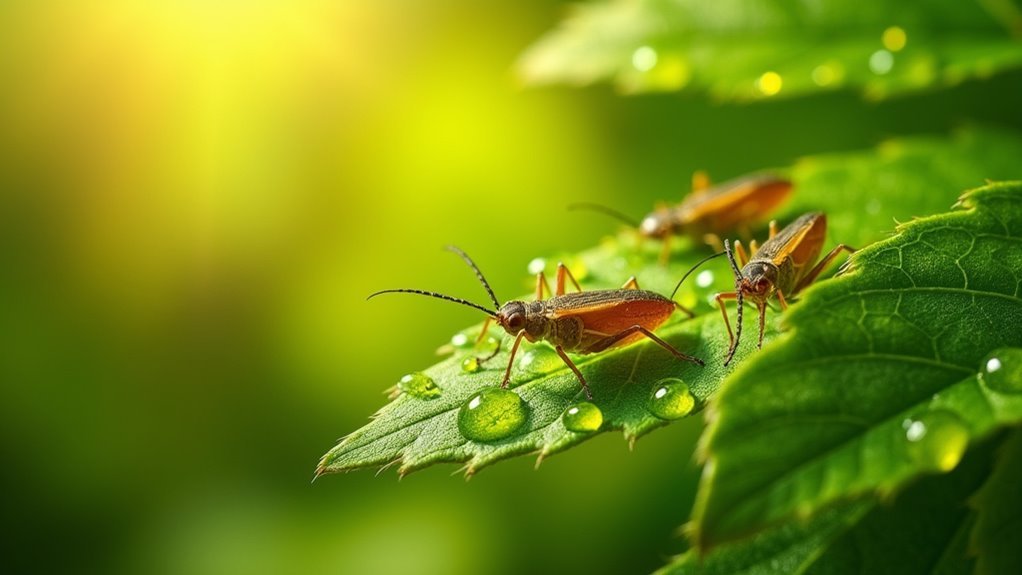
You’ll find that neem oil’s effectiveness against thrips comes from specific active compounds that target these pests at a molecular level.
Azadirachtin stands out as the primary insect disruptor, interfering with thrips’ hormonal systems and preventing normal feeding behavior.
Additionally, limonoids work alongside azadirachtin to block thrips development, creating a multi-layered defense that stops reproduction and growth cycles.
Azadirachtin’s Insect Disruption
Deep within neem oil lies azadirachtin, a powerful bioactive compound that serves as your primary weapon against thrips infestations. This naturally occurring insecticide works by disrupting the hormonal processes that control thrips’ growth and reproduction, effectively breaking their life cycle.
| Azadirachtin Effect | Impact on Thrips |
|---|---|
| Hormonal Disruption | Prevents molting and development |
| Feeding Deterrent | Causes thrips to stop eating |
| Growth Inhibition | Stunts larval development |
| Reproductive Block | Reduces egg laying capacity |
| Defense Enhancement | Strengthens plant resistance |
When you apply neem oil, azadirachtin doesn’t just kill adult thrips—it targets their larvae too. You’ll notice thrips stop feeding almost immediately, and higher concentrations deliver faster, more dramatic results. The compound also boosts your plant’s natural defenses, creating lasting protection against future invasions.
Limonoids Block Development
Beyond azadirachtin, neem oil contains an entire family of limonoids that work together to shut down thrips development at multiple stages.
These powerful compounds don’t just kill adult thrips—they systematically dismantle the pest’s entire life cycle.
Here’s how limonoids target thrips development:
- Hormonal disruption – They interfere with growth hormones, preventing larvae from molting properly.
- Reproductive interference – Limonoids disrupt mating behaviors and egg production in adult thrips.
- Feeding inhibition – Young larvae can’t feed effectively, leading to starvation and death.
- Population control – Consistent applications reduce thrips numbers by up to 90%.
You’ll find these limonoids also deter other garden pests, making neem oil an excellent choice for extensive pest management strategies.
Creating Your Organic Neem Oil Thrips Control Recipe
You’ll need just three essential ingredients to create an effective neem oil thrips control solution: pure neem oil, water, and mild dish soap.
The proper mixing ratio is straightforward—combine 2 tablespoons of neem oil with 1 gallon of water, then add a few drops of dish soap to help the oil blend smoothly.
Getting your application technique right means spraying both the top and bottom surfaces of leaves where thrips hide, plus treating the surrounding soil for complete coverage.
Essential Neem Oil Ingredients
When creating an effective neem oil solution for thrips control, you’ll need just three essential ingredients that work together to combat these destructive pests.
The primary component is neem oil itself, which contains azadirachtin—a powerful natural compound that disrupts thrips’ life cycles by inhibiting their growth and reproduction.
You’ll also need water to dilute the oil to proper concentration, and mild liquid soap that acts as an emulsifier, helping the oil mix effectively with water.
Here’s your simple ingredient list:
- 2 tablespoons of pure neem oil – provides the active pest-fighting compounds
- 1 gallon of water – creates the proper dilution ratio
- Few drops of mild liquid soap – guarantees ingredients blend smoothly
- Spray bottle or garden sprayer – for easy application
This biodegradable combination creates a protective barrier that makes feeding difficult for thrips while remaining safe for your plants and beneficial insects.
Proper Mixing Ratios
Getting the mixing ratios right determines whether your neem oil solution will effectively control thrips or potentially harm your plants.
You’ll want to mix 2 tablespoons of neem oil with 1 gallon of water for a potent thrips-fighting solution. Don’t forget to add a few drops of liquid soap—this helps emulsify the oil and guarantees even coverage across your plant surfaces.
Always shake the mixture thoroughly before application. This step’s vital because it integrates the neem oil fully, maximizing its effectiveness against thrips.
Apply your solution during early morning or late afternoon hours to prevent leaf burn and enhance plant absorption. Reapply every 7 to 14 days, or after heavy rainfall, to maintain that protective barrier against thrips and other garden pests.
Application Best Practices
Creating your organic neem oil thrips control recipe starts with gathering the right ingredients and following precise steps for maximum effectiveness.
You’ll need pure neem oil, water, and liquid soap to create a potent solution that targets these destructive pests.
Follow these essential steps for ideal results:
- Mix the solution – Combine 2 tablespoons of pure neem oil with 1 gallon of water, adding a few drops of liquid soap as an emulsifier.
- Target all surfaces – Spray directly onto affected leaves, covering both tops and undersides where thrips hide.
- Time your application – Apply during early morning or late evening to avoid direct sunlight interference.
- Maintain consistency – Repeat every 7-14 days until infestation clears, monitoring plants closely between treatments.
Proper Application Techniques for Maximum Effectiveness
Since neem oil’s effectiveness against thrips depends heavily on proper application, you’ll need to focus on concentration, timing, and coverage to achieve ideal results.
Mix your solution at 1-2% concentration by diluting neem oil with water and adding a few drops of mild soap for better leaf adherence.
Apply during early morning or late afternoon to prevent sunlight from degrading the oil’s potency and potentially damaging your plants.
Cover both leaf surfaces thoroughly, paying special attention to undersides where thrips commonly hide.
Reapply every 7-14 days, particularly after rain or watering, to maintain protection against re-infestation.
Always conduct a patch test on a small plant area first to guarantee no adverse reactions occur before treating the entire plant.
Timing Your Neem Oil Treatments for Best Results
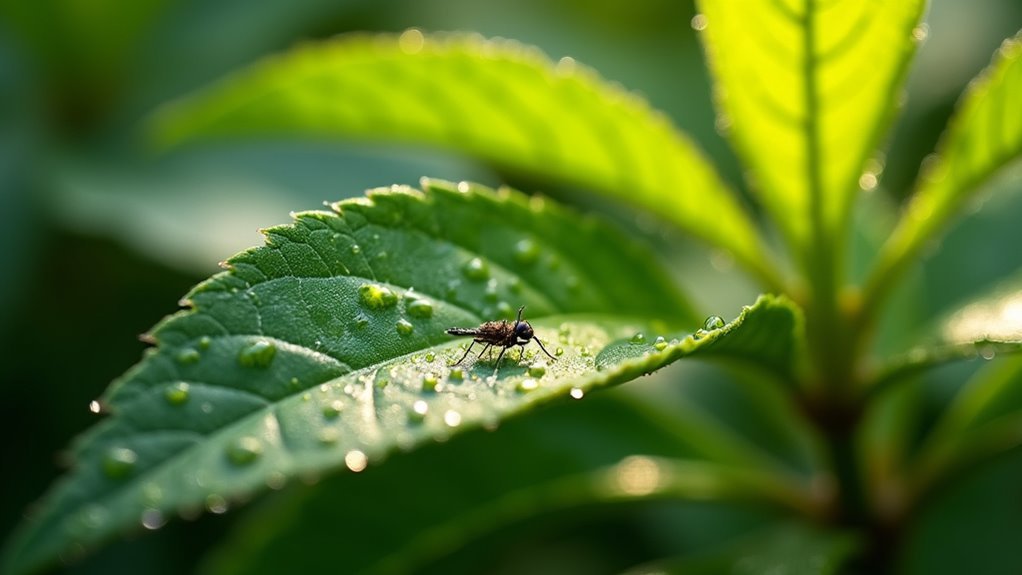
You’ll achieve the best results against thrips when you time your neem oil treatments strategically around three key factors.
Detecting infestations early allows you to disrupt thrips before they establish large populations, while maintaining a consistent application schedule prevents gaps in protection.
The time of day you apply neem oil also matters greatly, as cooler temperatures enhance absorption and prevent leaf damage.
Early Detection Benefits
When you catch thrips infestations early, you’ll gain a significant advantage in controlling these destructive pests with neem oil.
Regular plant monitoring enables you to spot these tiny insects before they establish large populations and cause extensive damage.
Early detection provides these key benefits:
- Interrupts life cycles – Neem oil effectively breaks the reproductive cycle before thrips multiply exponentially.
- Creates protective barriers – Early application forms a defensive shield that prevents further pest establishment.
- Maximizes treatment effectiveness – Smaller populations are easier to eliminate than mature infestations.
- Reduces plant damage – Prompt intervention minimizes feeding damage and stress to your plants.
You’ll achieve the best results by timing your neem oil treatments during active feeding periods when thrips are most vulnerable to the oil’s effects.
Application Frequency Schedule
Three critical factors determine your neem oil application schedule: infestation severity, environmental conditions, and plant response.
You’ll need to apply treatments every 7 to 14 days for effective thrips control. Severe infestations require more frequent applications, while lighter problems can handle longer intervals.
Time your applications during early morning or late evening hours. This prevents rapid evaporation and allows maximum plant absorption.
You must thoroughly coat both upper and lower leaf surfaces, since thrips hide underneath leaves.
Reapply neem oil immediately after heavy rain or watering, as water washes away the protective barrier.
Monitor your plants closely after each treatment to gauge effectiveness. If you’re still seeing thrips activity, shorten the interval between applications until you achieve control.
Best Time Daily
Daily timing can make or break your neem oil treatment’s effectiveness against thrips.
You’ll get the best results when you apply neem oil during cooler parts of the day, avoiding the harsh midday sun that can cause leaf burn and reduce absorption.
Here’s your ideal timing strategy:
- Early morning application – Apply between 6-9 AM when temperatures are cool and humidity is higher.
- Late afternoon treatment – Target 4-7 PM when the sun’s intensity decreases.
- Ensure dry conditions – Wait until morning dew evaporates or evening moisture subsides.
- Avoid windy periods – Choose calm conditions for better coverage and adherence.
This timing maximizes neem oil’s absorption into plant tissues while protecting your plants from heat stress and ensuring the treatment sticks properly to leaf surfaces.
Combining Neem Oil With Physical Removal Methods
Two complementary approaches work better than either method alone when you’re battling thrips infestations.
Start by showering your plant thoroughly to physically remove visible thrips, then apply neem oil while the surface is still damp. This sequence guarantees the oil reaches remaining pests more effectively since you’ve already eliminated the bulk of the population.
After the neem oil dries, wipe your plant’s leaves multiple times to create a clean surface that makes reestablishment difficult. The oil continues working as a protective barrier and repellent, suffocating any remaining thrips while deterring new ones from settling.
This combined approach doesn’t just target current infestations—it creates an unfavorable environment that prevents future problems.
Regular monitoring and maintenance using both methods leads to long-term thrips management.
Safety Considerations When Using Neem Oil on Plants
While neem oil offers effective thrips control, you’ll need to follow proper safety guidelines to protect both your plants and beneficial garden visitors.
Before treating your entire garden, test neem oil on a small plant section to check for adverse reactions. This simple step prevents widespread damage if your plants are sensitive.
Here are essential safety practices:
- Apply during cooler hours – Use neem oil in early morning or late afternoon to prevent sunlight-induced leaf burn.
- Follow manufacturer instructions – Stick to recommended dilution ratios and application methods for maximum safety and effectiveness.
- Avoid beneficial insect activity periods – Time applications when pollinators and helpful insects aren’t active.
- Test first, treat second – Always spot-test before full application.
These precautions guarantee you’ll eliminate thrips while maintaining a healthy garden ecosystem.
Comparing Neem Oil to Other Organic Pest Control Options
How does neem oil stack up against other organic pest control methods when you’re battling thrips?
You’ll find neem oil offers unique advantages through its hormonal disruption approach, preventing thrips from maturing and reproducing effectively. Unlike white oil, which works through suffocation and targets a broader pest range, neem oil provides more targeted action against thrips specifically.
When you’re dealing with severe infestations, white oil’s suffocating effect might prove more immediately effective across multiple pest types.
However, neem oil’s residual effects give you longer-lasting protection, continuing to deter thrips after initial treatment.
You’ll also appreciate that neem oil maintains safety for beneficial insects when applied correctly, making it an environmentally conscious choice that doesn’t compromise your garden’s ecosystem balance.
Signs That Your Neem Oil Treatment Is Working
After applying neem oil to combat thrips, you’ll want to monitor your plants for specific indicators that the treatment is taking effect.
- Reduced thrips population – You’ll notice fewer visible thrips on leaves and surrounding areas within a week of application, signaling the treatment’s effectiveness.
- Decreased plant damage – Look for fewer discolored or distorted leaves, indicating that thrips aren’t causing as much harm to your plants.
- Healthier new growth – As thrips stress diminishes, you’ll observe fresh, vigorous growth emerging from your treated plants.
- Sluggish pest behavior – Thrips and their larvae will become lethargic and move less frequently as neem oil interferes with their feeding and reproduction cycles.
The protective sheen remaining on leaves also indicates continued protection against future infestations.
Preventing Future Thrips Infestations With Neem Oil
Beyond treating existing infestations, neem oil serves as your plant’s long-term defense system against future thrips invasions. The oil creates a protective barrier that makes your plants an inhospitable environment for these pests. Its active compounds disrupt thrips’ hormonal systems, preventing them from maturing and reproducing on treated surfaces.
You’ll need to maintain regular applications every 7-14 days, especially during peak pest seasons, to guarantee continuous protection. This consistent schedule keeps the deterrent effect strong and prevents new thrips from establishing colonies.
Combine your neem oil treatments with ongoing plant health monitoring for maximum effectiveness. When you maintain this proactive approach, you’re not just solving current problems – you’re building a sustainable defense that keeps thrips away long-term.
Troubleshooting Common Neem Oil Application Mistakes
While neem oil is highly effective against thrips, improper application techniques can greatly undermine your pest control efforts. Common mistakes can render your treatment ineffective and potentially harm your plants.
Here are the most critical application errors to avoid:
- Incorrect dilution ratios – Always follow manufacturer instructions precisely, as wrong concentrations reduce effectiveness against thrips.
- Poor timing – Apply during cooler parts of the day (early morning or late afternoon) to prevent leaf burn and enhance absorption.
- Inadequate coverage – Thoroughly coat both leaf surfaces, especially undersides where thrips hide.
- Mixing incompatible products – Don’t combine neem oil with other pesticides unless compatibility is confirmed.
Reapply every 7-14 days to maintain protection and disrupt thrips’ life cycles effectively.
Frequently Asked Questions
How Effective Is Neem Oil on Thrips?
Neem oil’s highly effective against thrips, reducing populations by up to 80% when you apply it correctly. You’ll disrupt their life cycle, inhibit feeding behavior, and create a protective barrier that prevents establishment on your plants.
Why Are Thrips so Hard to Get Rid Of?
You’ll struggle with thrips because they reproduce rapidly, hide in hard-to-reach plant areas, develop pesticide resistance, and disperse quickly with their wings, making detection and targeted treatment extremely challenging.
What Happens if You Spray Too Much Neem Oil on Plants?
If you spray too much neem oil, you’ll cause leaf burn, yellowing, and curling. You’ll also suffocate beneficial insects, block plant pores, impair photosynthesis, and create residue that attracts more pests.
Can Pests Become Resistant to Neem Oil?
Yes, pests can develop resistance to neem oil if you use it repeatedly without rotation. You’ll need to implement integrated pest management strategies and alternate treatments to prevent thrips from becoming resistant.
In Summary
You’ve now got the knowledge to tackle thrips with neem oil’s natural power. Don’t wait until you see damage—start your preventive treatment schedule today. Remember, consistency beats intensity when you’re applying neem oil. Check your plants weekly, adjust your spray timing based on weather, and you’ll keep these tiny pests from destroying your garden. Your plants will thank you with healthier growth and better yields.

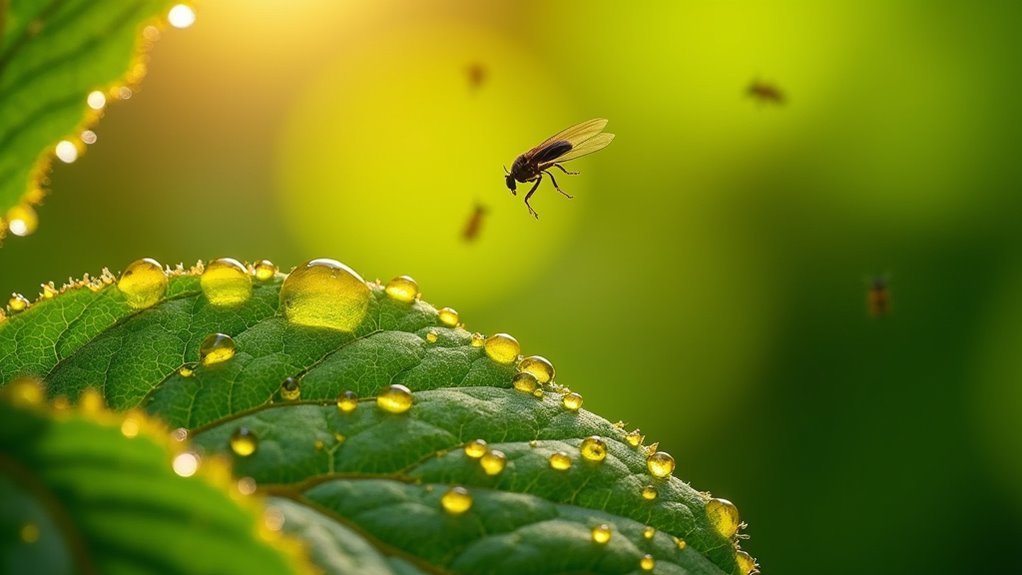

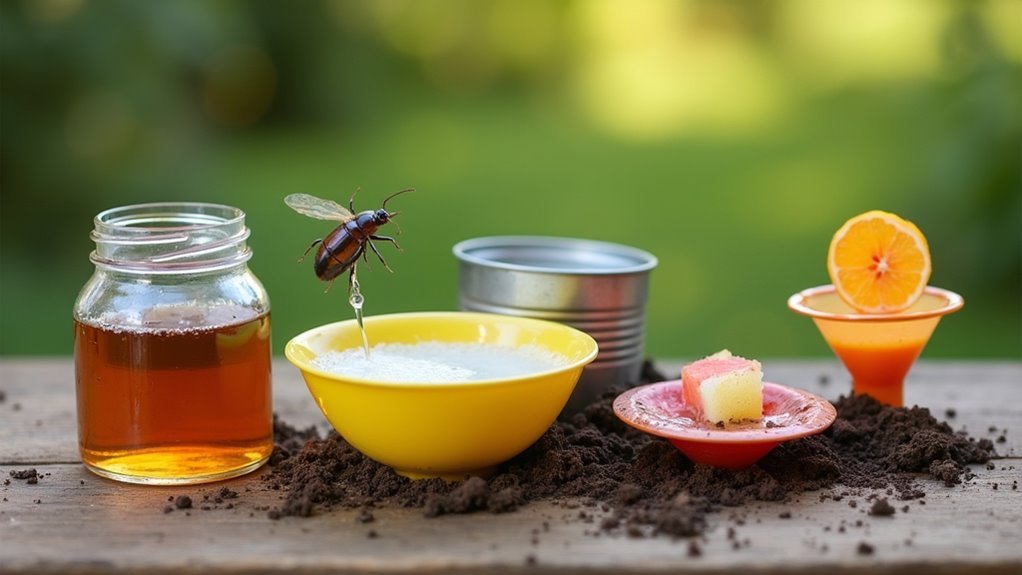

Leave a Reply